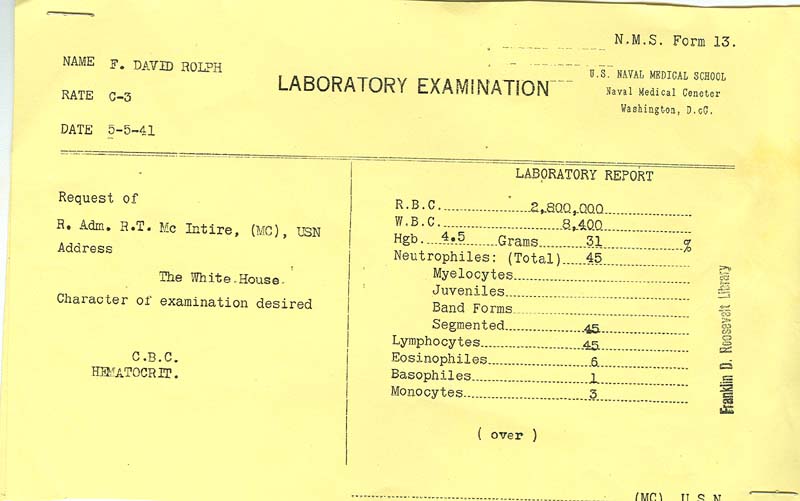

⬅ Franklin Roosevelt: Lab Slip Showing Anemia

The white blood cell count ("W.B.C.") is not reduced, suggesting (but not proving) the anemia was not due to bone marrow failure.
At first Dr. Zebra thought there was a dissociation between the hemoglobin level ("Hgb" on the lab slip) and the hematocrit ("Grams %"). The former measures the amount of hemoglobin protein in the blood. Hematocrit measures the amount of space in the blood that is occupied by red blood cells. Normally the hematocrit is three times the value of the hemoglobin, but the lab slip shows the hematocrit as SEVEN times larger than the hemoglobin.
Examination of other lab slips discloses that the "Grams %" is not really a hematocrit measurement. It is more like "percentage of normal hemoglobin level." Thus, even though McIntire requested a hematocrit number, he was not given one.
From the red blood cell count and the hemoglobin, it is possible to calculate a mean corpuscular hemoglobin (MCH) as (Hemoglobin) / (Red Blood Cell Count) 2, which yields:
MCH = (4.5 g Hb/dl) / (2.8e6 cells/mcl)MCH = [(4.5 g Hb · mcl ) / (2.8e6 cells · dl)] * (10 dl/liter) * (1 liter / 1e6 mcl)
MCH = (45 g Hb) / (2.8e12 cells)
MCH = 16 g Hb/cell
This value of MCH is indicative of iron deficiency -- no surprise since bleeding was the cause of anemia. However, it does establish that the bleeding was chronic, rather than acute.
- Bruenn, HG. Clinical notes on the illness and death of President Franklin D. Roosevelt. Ann Int Med. 1970;72: 579-591. Pubmed: 4908628.
- Available on the web: http://www.fpnotebook.com/hemeonc/lab/MnCrpsclrHmglbnCncntrtn.htm